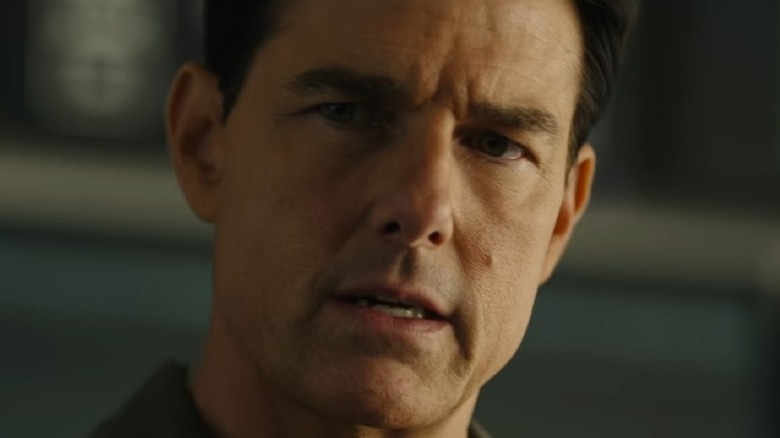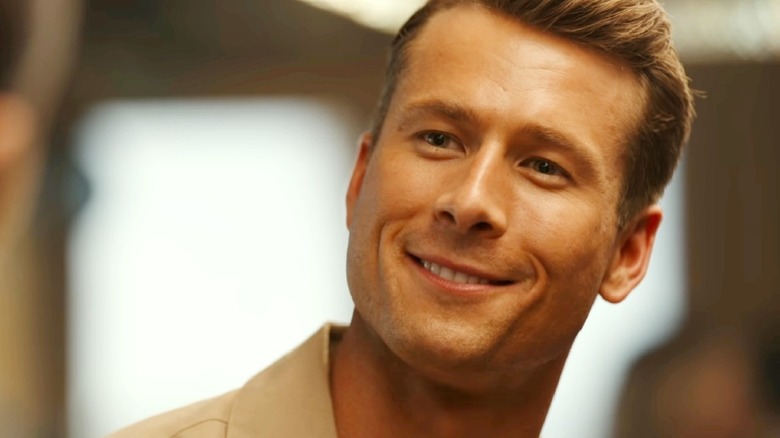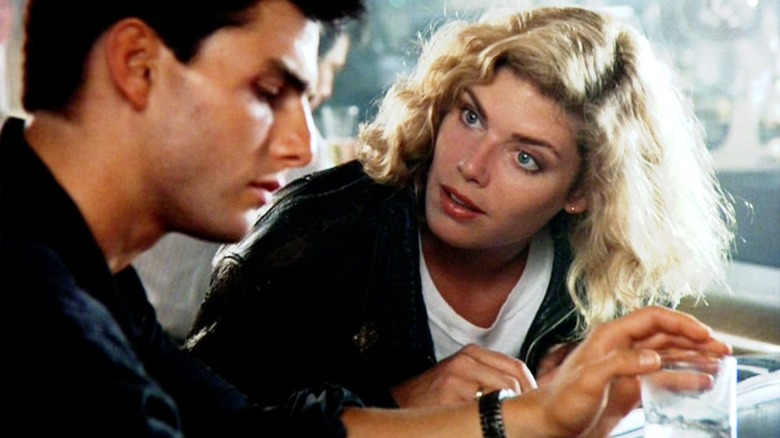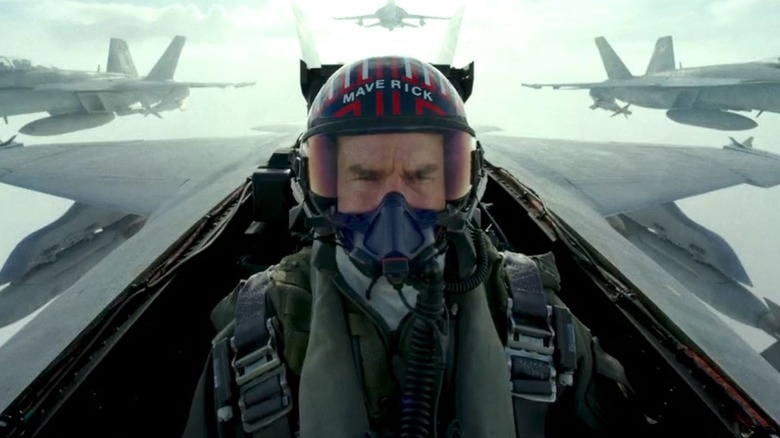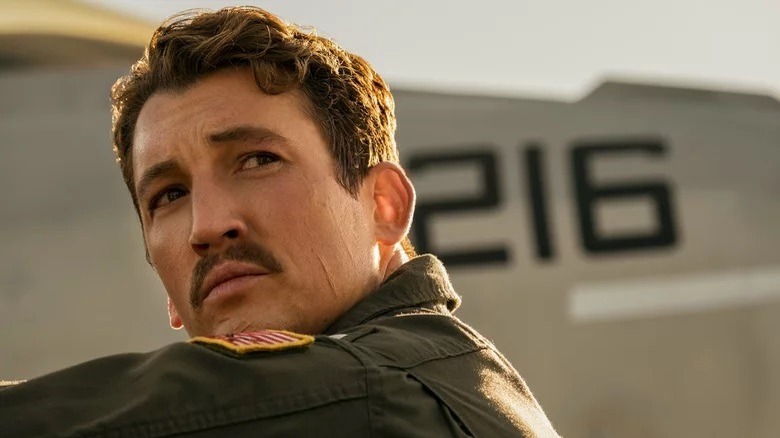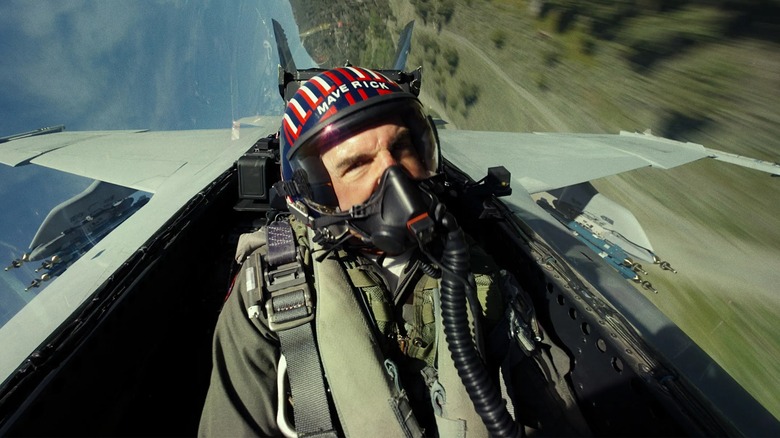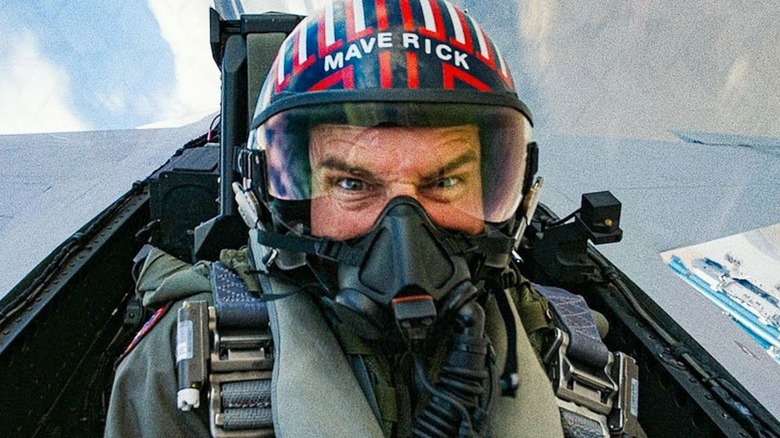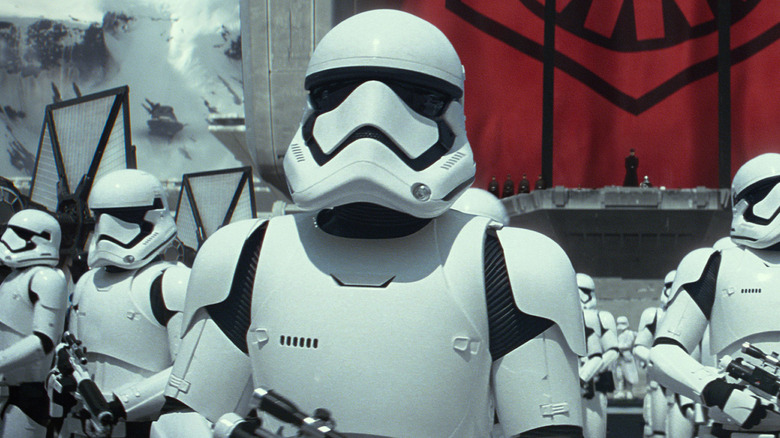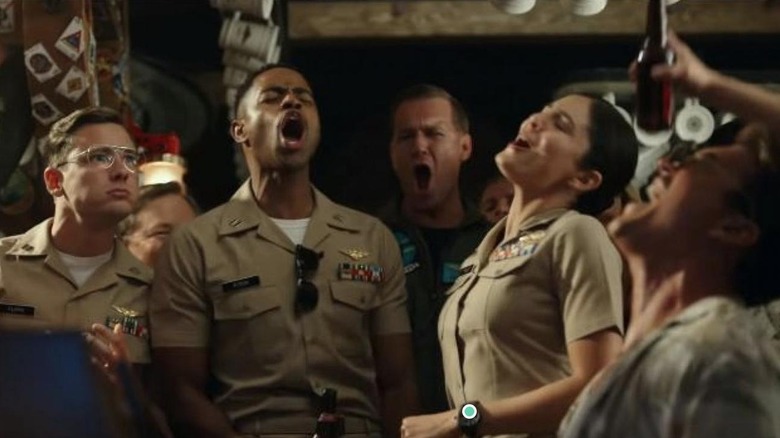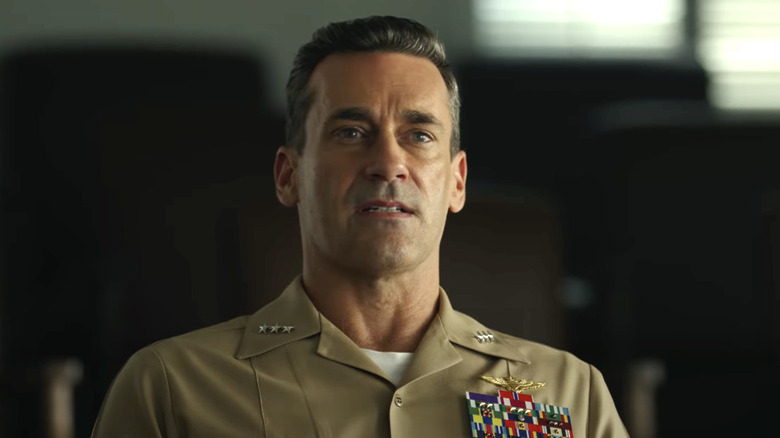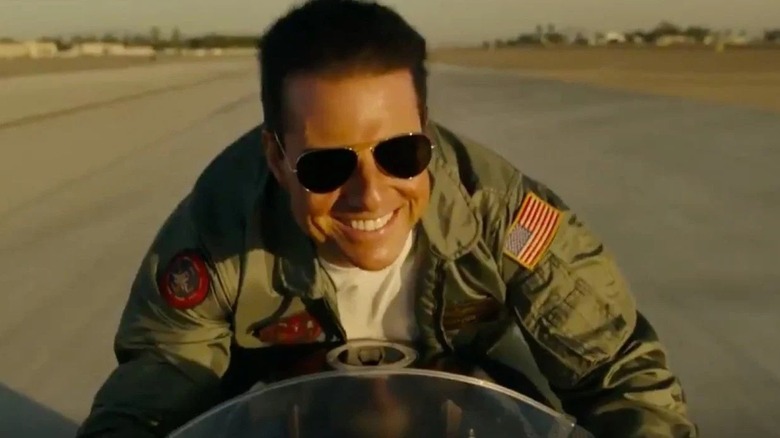Biggest Unanswered Questions From Top Gun: Maverick
After 36 years, Tom Cruise's Maverick is back on the highway to the danger zone in "Top Gun: Maverick." While a sequel this overdue has understandably drawn some skepticism, the movie defies the dreaded sequelitis and has critics all saying the same thing about it: to put it simply, the film takes people's breath away.
With a new cast of characters introduced, and a different mission at hand, this isn't the same "Top Gun" that was initially released in 1986. In fact, by the end of this film, there are a few loose threads that leave us pondering if they will ever be wrapped up or addressed. These aren't necessarily criticisms or gripes about the film or its quality, but merely curious observations that merit conversation and debate. With that said, let's take a look at the biggest unanswered questions from "Top Gun: Maverick." (Beware the spoilers ahead!)
How has Hangman gotten so far with his recklessness?
In "Top Gun: Maverick," Lieutenant Jake "Hangman" Seresin (Glen Powell) is the Maverick archetype of the film. There is no disputing his talent as a pilot and how he possesses all the necessary tools to succeed in Top Gun, but he also holds many of Maverick's most undesirable qualities as a younger pilot such as recklessness, selfishness, a blatant disregard of orders, and, well, a pretty punchable face. In fact, he could be far worse and more unmanageable than Maverick.
Taking into account Hangman's cowboy reputation and his inability to play well with others, why is he even drafted into a group for the special mission in the first place? Undoubtedly, Vice Admiral Beau "Cyclone" Simpson (Jon Hamm) must have read up on his history to know that he has a propensity to fly solo rather than as a unit, so it's mind-blowing he would even think that Hangman would suddenly become a team player in a few weeks. Sure, there's the argument that his defiance of the rules is what saves Maverick and Rooster in the end, but that doesn't excuse the fact that he has the wrong characteristics to be a part of the unit to begin with.
Where is Charlie?
"Top Gun: Maverick" sees the return of some familiar faces from the first film — namely Pete "Maverick" Mitchell and Tom "Iceman" Kazansky (Val Kilmer). It also addresses what happened to Carole Bradshaw (Meg Ryan), revealing to the viewers that she passed away some years earlier. However, the movie never discusses what has happened to Charlie Blackwood (Kelly McGillis), Maverick's love interest from the 1986 film; instead, Jennifer Connelly fills a similar role as Penny Benjamin, but what makes this even stranger is the fact that Charlie shows up in old photographs and in a cringe-worthy flashback appearance, yet no one explains where she is or why she is no longer with Maverick at this point.
It turns out that McGillis doesn't know what happened to Charlie either, as no one reached out for her to return for the sequel. That said, she holds no grudges over Connelly being cast as the new love interest in the franchise and told Entertainment Tonight she is "so glad that she got that opportunity." "Top Gun: Maverick" director Joseph Kosinski, revealed to Insider that Charlie's return was never a part of the plan as the movie didn't want to stay too rooted in the past.
Why don't the Top Gun team get better jets?
From the get-go, it is clear that the Top Gun team chosen for the special mission is probably doomed. No one believes they will successfully execute the mission objective and get out of enemy territory alive, especially with the risk of going up against the enemies' fifth-generation Su-57 fighter jets and the tricky terrain. However, they are given F/A-18s, Maverick's knowledge, and a few Hail Marys before they are sent on their merry way to the danger zone.
But why doesn't the U.S. naval force provide the team with more high-tech aircraft to begin with? The Lockheed Martin F-35 Lightning II, for example, is considered one of the most advanced fighter jets and contains the next-level stealth and sensor technologies that would be a major advantage for a mission of this magnitude. The question is, would the F-35 handle as well as the F/A-18s in the required environment and under those specific conditions?
Will Maverick ever tell Rooster about his mother's secret?
One of the biggest plot points of "Top Gun: Maverick" is Maverick having to be an instructor to Lieutenant Bradley "Rooster" Bradshaw (Miles Teller), the son of his deceased former partner Goose (Anthony Edwards). Instead of focusing on Rooster holding resentment towards Maverick for his father's death, the film decides to take a different approach — it shows how Maverick is responsible for pulling Rooster's application to the Naval Academy and causing him to lose a few years of his flying career. Naturally, this decision causes friction between the two men.
Later in the movie, it is revealed that Rooster's mother asked Maverick to pull her son's application, fearing the same fate would fall on her boy that had ended her husband's life. Maverick never reveals this important detail to Rooster, deciding that the young pilot should resent him and not his mother for what happened. While Maverick and Rooster are in a much better place by the end of the film, the secret remains. Undoubtedly, the two will have more conversations about Rooster's academy years, and one has to wonder if Maverick will eventually reveal the truth about why he did what he did. Maybe the answer will be revealed in "Top Gun: Rooster."
How does Maverick manage to take the jet up into the air without anyone noticing?
Security at an airfield is incredibly tight. Not only do pilots need special clearance and the right identification on them at all times, but there are many additional layers of security to pass through before even thinking of taking to the skies. If these measures aren't in place, aircraft could crash into each other on the runway. Yet, "Top Gun: Maverick" makes it look as simple as walking into a hangar, picking out a favorite jet, and saluting fellow pilots before takeoff.
After Vice Admiral Simpson takes over the training for the mission and dismisses Maverick from his duties, he is surprised as everyone else to see that Maverick has taken an aircraft to prove how the mission can be executed in his specific way. Not only is this deliberate insubordination and technically theft of military property, but it also illustrates that Top Gun's security must be run by the same people who train the useless Gotham City Police Department. Surely, there must be some form of clearance needed before Maverick can take a jet out on a joyride?
How is Maverick able to survive Mach 10?
In movies, it's important to suspend disbelief at the best of times since many creative liberties are taken for the sake of a good story. In "Top Gun: Maverick," the concept of breaking Mach 10 (i.e., going 10 times beyond the speed of sound), is introduced on several occasions. Of course, it is Maverick who breaks this distinguished record and has everyone in awe at his jaw-dropping feat. However, he takes it a step further and tries to go even faster, ultimately destroying his aircraft — but he escapes unharmed. While it might sound incredible, it is also highly unrealistic that Maverick's head doesn't pop from all that pressure in the cabin as a result of him pushing the death-defying limits.
According to 19FortyFive, NASA's X-43 only reached Mach 9.6, and this was considered a monumental event in flight history. The material of the aircraft and the fitness level of the pilot would make a massive difference if anyone tried to break this speed in the first place. While Maverick is undoubtedly a talented pilot — and one who would likely attempt to do this — he might not have survived it in the real world.
Are the enemy jets secretly Stormtroopers?
As soon as the special mission is announced, it is made clear that the Top Gun team might not make it back. Going into enemy territory is one thing, but they also have to contend with fifth-generation fighter jets that possess better technology than their F/A-18s. The outlook looks bleak, but the Top Gun team manages to pull off the mission without any casualties — though the millions of dollars in damage probably makes a few of the big cheeses grimace. But is their success because of their superior flying skills or the bulletproof plan?
Nope, it is because the enemy pilots have the aim of Stormtroopers. While hitting a moving target is highly difficult, these superior aircraft should have better sensors and weapons technology systems. Yet, they hardly scratch the surface of the old, rusty F-14A Tomcat that Maverick and Rooster steal from them. Sure, they may brush the aircraft with a few bullets, but this is the equivalent of a Fiat Uno beating a BMW M3 in a drag race. A good pilot will always know how to control the machine, but let's not disrespect the influence of technology and how it has improved aviation.
Why aren't more established pilots chosen for the mission?
The team chosen for the mission is described as the best and most elite fighter pilots around. However, they are inexperienced and don't know how to work as a unit, which is why Maverick is brought in, to train them and impart his experience. They need someone to harness their natural ability and turn them into a formidable team within the space of three weeks.
While it's never too late to learn or upskill, why doesn't the mission demand more experienced pilots or choose ones who have gone out on similar missions in the past? With a critical and complex assignment such as this one and a limited time to get everyone ready, it makes sense to go for experience over raw talent here. Again, this leaves the impression that the Top Gun team was seen as disposable. Maybe Vice Admiral Simpson is the Amanda Waller here, while Maverick is seen as Rick Flag.
Why isn't the team court martialed for not following orders?
Across both "Top Gun" films, one thing is abundantly clear: the rules are optional for the pilots and there are no consequences for ignoring them. The pilots put each other and the missions in jeopardy as they believe they know better and disobey direct orders from their superiors. Now, while rulebreakers are common across every facet of life, naval forces are renowned for being extremely strict about the rules and protocols. It's for this reason alone that most people don't make the final cut, since obedience isn't just a nice-to-have quality here.
Towards the end of "Top Gun: Maverick," Rooster and Hangman openly deft direct orders from Vice Admiral Simpson. Instead of being grilled and court-martialed upon arrival at the base, they are celebrated as heroes for their actions. It can be disputed whether they've done the "right" thing, but what does this mean about their level of respect for Simpson as a superior and his instructions? Additionally, Simpson isn't left in a good light either since he is defied on several occasions and simply lets it go. This doesn't bode well for him as an authority figure who is hoping to be taken seriously or to rise through the ranks.
What will Maverick do now?
After Maverick is dismissed from the U.S. Navy and redeployed to Top Gun as an instructor, he is told that it is his last chance saloon. So if he wants to be around aircraft, this is the only option that he had. At the same time, it is revealed that Iceman, who served as an admiral, has saved his old pal numerous times by putting in a good word when he's chosen to ignore the rules.
Well, the ending of "Top Gun: Maverick" leaves Maverick in something of a sticky predicament. He has successfully trained the team for the mission and the assignment is now over. More importantly, with the death of Iceman, he no longer has an ally who will go out and bat for him when he chooses to disobey instructions and be a general thorn in the side of authority. Retirement could be the only option he has because let's be honest: even if he stays on as an instructor at Top Gun, he is bound to upset someone in a position of power by not following their orders.
